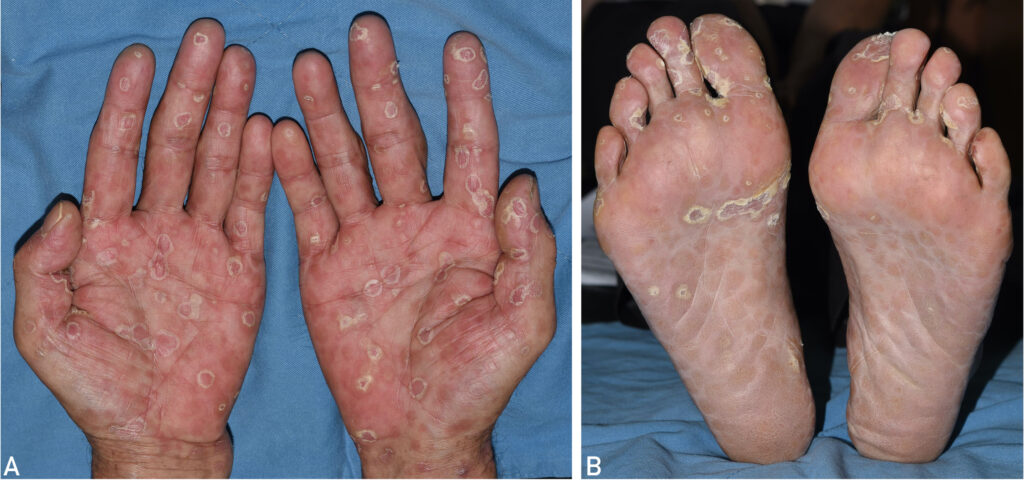Secondary syphilis is the second stage of the sexually transmitted infection caused by Treponema pallidum, typically occurring weeks to a few months after the initial chancre of primary syphilis heals. It is marked by systemic dissemination of the spirochete, resulting in a wide range of dermatologic, mucosal, and systemic manifestations.

Pathogenesis and Transmission
The pathogen Treponema pallidum enters through mucosal surfaces or microabrasions during sexual contact. After initial local infection (primary chancre), the organism spreads hematogenously, triggering widespread immune responses responsible for secondary stage symptoms.
Transmission occurs primarily through:
- Sexual contact (vaginal, anal, or oral)
- Direct contact with mucocutaneous lesions
- Less commonly, through blood transfusion or vertical (mother-to-child) transmission
Clinical Presentation of Secondary Syphilis
Cutaneous and Mucocutaneous Lesions
- Generalized Rash: Most characteristic, often involving the trunk and extremities, notably the palms and soles. The rash is typically non-pruritic and may be macular, papular, or pustular.
- Mucous Patches: Painless, grayish-white lesions on oral, genital, or perianal mucosa.
- Condylomata Lata: Moist, highly infectious papular lesions in warm intertriginous areas (e.g., perineum, inner thighs).
- Alopecia: Patchy hair loss (“moth-eaten” appearance), especially affecting the scalp, eyebrows, or beard.
Systemic Symptoms
- Fever
- Malaise
- Weight loss
- Lymphadenopathy (widespread, painless, symmetrical)
- Sore throat
- Myalgia
- Hepatosplenomegaly in some cases
Differential Diagnosis
Given its diverse manifestations, secondary syphilis is often called “the great imitator.” Conditions to consider include:
- Pityriasis rosea
- Psoriasis
- Drug eruptions
- Viral exanthems
- HIV-related skin manifestations
- Lichen planus
- Reactive arthritis
Diagnostic Approach to Secondary Syphilis
Serologic Testing
Two types of tests are essential:
- Non-Treponemal Tests (screening and monitoring):
- Venereal Disease Research Laboratory (VDRL)
- Rapid Plasma Reagin (RPR)
These yield titers that correlate with disease activity.
- Treponemal Tests (confirmation):
- Fluorescent treponemal antibody-absorption (FTA-ABS)
- T. pallidum particle agglutination (TPPA)
- Enzyme immunoassay (EIA)
Additional Evaluation
- HIV Testing: Coinfection is common
- Neurological assessment: If neurologic signs are present, consider lumbar puncture for neurosyphilis
- Darkfield microscopy or PCR: Rarely used due to limited availability
Management and Treatment of Secondary Syphilis
First-Line Therapy
- Benzathine Penicillin G (2.4 million units IM in a single dose) is the treatment of choice.
Alternatives (for penicillin-allergic patients)
- Doxycycline 100 mg orally twice daily for 14 days
- Ceftriaxone (off-label use) may be considered under specialist guidance
Special Populations
- Pregnancy: Penicillin is mandatory; desensitization required if allergic
- HIV-Positive Patients: May need closer follow-up due to increased risk of treatment failure
Follow-Up and Monitoring
- RPR/VDRL titers: Recheck at 6 and 12 months to confirm treatment response (≥4-fold titer decline)
- Clinical evaluation: Monitor for recurrence or progression to latent or tertiary stages
- Sexual partners: All partners within the preceding 90 days should be notified, tested, and treated empirically
Prevention and Public Health Considerations
Risk Reduction Strategies
- Use of condoms and dental dams
- Regular STI screening in sexually active individuals
- Prompt treatment of infected individuals and their partners
- Pre-exposure counseling and behavioral interventions
Public Health Reporting
Syphilis is a notifiable disease. Prompt reporting enables partner tracing, community surveillance, and outbreak control.
Complications of Untreated Secondary Syphilis
If left untreated, secondary syphilis progresses to the latent stage, which may eventually lead to:
- Tertiary syphilis (gummatous lesions, cardiovascular syphilis, neurosyphilis)
- Congenital syphilis in pregnant individuals
- Increased risk of HIV transmission and acquisition
Secondary syphilis remains a crucial diagnostic and therapeutic challenge due to its protean manifestations. Early recognition and appropriate treatment are essential not only for individual prognosis but also for broader public health control. With timely intervention, this stage is fully curable, preventing long-term sequelae and transmission to others.